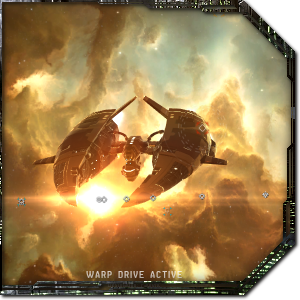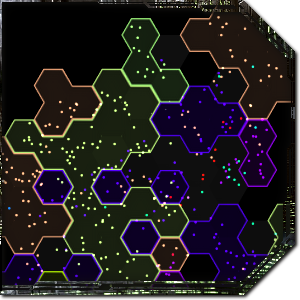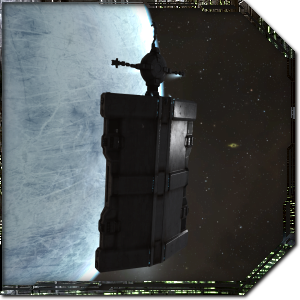
When CCP announced its far-reaching plans to overhaul EVE Online‘s territorial warfare gameplay, players were cautiously optimistic but understandably guarded. EVE‘s old sovereignty system saw the game’s signature political rivalry and emergent warfare gradually morph into a stagnant universe in which a few massive coalitions held practically all of the power. What started out as alliances naturally joining forces against common enemies ended up with just a handful of groups controlling almost all of the lawless nullsec regions, a situation that nobody (not even the coalitions themselves) was happy with.
Independent alliances and individual corporations are still forced by neccessity to gain powerful allies or join an existing coalition if they want to play any part in EVE‘s territorial endgame. The jump fatigue feature introduced in November’s Phoebe release and the recent changes in Mosaic have helped force alliances contract into smaller territories and shattered many renter empires, but those are just the first steps in a much grander plan. EVE is heading into a golden age in which any corporation can build its own little empire and independent alliances may actually be able to defend their space from attack, and it all begins this summer.
In this edition of EVE Evolved, I look at the latest details of this summer’s sovereignty overhaul and the recently revealed Citadel structures that will let any corporation build its own little empire in the void of space.
 The trollceptorgeddon has been avoided
The trollceptorgeddon has been avoided
I was pretty critical of CCP’s initial plans for nullsec, and players had a wide range of questions and misgivings with the original proposal. I’m happy to report that player feedback on the new structure capture mechanics and entosis link module appear to have been taken on board. Fears of space being overrun with entosis-toting interceptors have been countered with a 25km range limitation on the frigate-sized entosis module and the addition of extra ship mass when the module is online. The larger tech 2 version has a 250km range and requires more powergrid and capacitor than a frigate can reasonably provide, limiting its effective use to cruisers and above.
A ship’s entosis uplink with a structure will be terminated if the ship loses its lock, but the module will still be stuck in an active state for the remainder of its cycle time. If the attacker is using a tech 1 link, that means he can’t warp or recieve remote assistance for up to five 5 minutes — plenty of time to turn his ship into a smudge in space. This forces a minimum level of commitment to every structure attack, making frivolous attacks worth responding to.
The entosis link will now consume strontium clathrates as fuel, and capital ships will have a 500% penalty to the module’s cycle time. This affects the warmup time before capturing begins and the duration left on a broken link if you’re hit with ECM, but not the actual capture rate once your warmup cycle has ended. Since it’s so easy to disrupt an entosis link or block it with a defensive link of your own, capture can’t realistically occur until the attacker has effective military control of the area the structure is in.
 Alliances becoming entrenched
Alliances becoming entrenched
The Command Node minigame I was critical of in a previous article is still going ahead as planned, with the small change that the defender will enjoy even bigger bonuses than previously announced. Structures in systems with high Military or Industrial indices will now take up to six times longer to capture than those in empty systems, giving the defenders more time to mobilise a response fleet. The activity defense multiplier now caps out at six, and the bonus is now much more heavily weighted toward star systems that are actively lived in. In fact, it won’t be possible to reach the 6x defensive multiplier cap in a star system without regular mining and ratting there.
When the command nodes spawn as part of a capture event, the attacker will capture at the standard speed while the defender will capture them up to six times faster. This acts as a kind of force multiplier, helping alliances become entrenched and making it more difficult to kick an active alliance out of its core systems. In combination with the entosis mechanic and last year’s jump fatigue changes, this should naturally lead to alliances shrinking into even smaller territories as they will occupy only the star systems they actively use. As an added bonus, each alliance will also able to designate one star system as its capital for a free +2x bonus to the system’s defense multiplier. That system will be able to hit the 6x defense multiplier cap even with very little mining or ratting going on.
 Time zone warfare and empty systems
Time zone warfare and empty systems
A lot of the player feedback on the original sovereignty proposal centred on the vulnerability window mechanic, which would make all structures invulnerable for about 18 hours per day. I had originally envisioned this as a replacement for reinforcement timers, but CCP is adamant about keeping them in. When a large structure is captured, it will become reinforced and a new timer will appear for the next capture event, with bigger structures needing to go through several capture phases on successive days before they finally change hands or are destroyed.
In response to player feedback, CCP has made two key changes to the vulnerability window mechanic. Each structure will be able to have its own separate vulnerability window, and the size of the window will scale heavily based on the system’s activity defense multiplier. A star system that’s barely used will be vulnerable to capture for 18 hours each day, allowing alliances in other time zones to potentially come in and steal it away without opposition. Active systems that are at the 6x defense multiplier cap will be vulnerable for only three hours each day, and structures in those systems will take around 60 minutes of uncontested battlefield supremacy to capture. The new mechanics make it a lot less feasible to hold onto star systems you don’t actually use, and there are bound to be plenty of empty systems up for grabs when this goes live over the summer.
 Citadels: Your very own space chateau
Citadels: Your very own space chateau
When we first heard about CCP’s plans for a complete structure overhaul at EVE Fanfest 2015, we were told to expect the first of these structures by the end of the year. I expected that we’d get some innocuous industrial modules first, but this week CCP revealed that the first set of structures to be released will be mini-stations! Nicknamed Citadels, the new structures will have docking capabilities and personal item and ship hangars for anyone who docks, though initially they won’t have the promised office rental or market facilities. We still don’t have a release date in sight for this first wave of new structures, but the latest devblog on them is packed with new details that have me very excited.
A medium-sized version intended for individuals and small groups will be released first, which will eventually serve as a replacement for the current starbase system. A large corporation-scale version will be released at the same time, with an extra large alliance-sized citadel to be released at a later date. Citadels will be constructible anywhere in space, with the exception of places near landmarks or inside anomalies or deadspace pockets. They also aren’t limited to nullsec, so you can build one in a good lowsec mining location or even in your favourite highsec system.
 Fighting over citadels
Fighting over citadels
One of the few restrictions on building a citadel is that you have to be part of a player-run corporation and thus potentially vulnerable to a corporate war declaration. Developers haven’t yet decided whether to make players scan for your structures with probes or to just put them on the discovery scanner, but it sounds as if it may be possible to hide a citadel in someone’s nullsec system and evade detection for weeks if nobody thinks to search for you. If it comes down to defending your citadel from an attack, you can also jump into it as if it’s an actual ship and use its weapons and defenses.
We now know that you’ll be able to choose between long- and short-range weapons of each type in addition to energy neutralisers, massive smartbombs, and waves of drones and fighters. The weapons are intended not to fight off an attack solo but to be used with a support fleet, so they may deal massive damage but will need stasis web and target painter support to hit. It’ll be like having a free stationary dreadnought to fight with, and there are even plans in the works for electronic warfare modules and doomsday-style superweapons for the larger citadels! If the worst should happen and your citadel is destroyed, it will drop some of the modules that were fitted to it as loot, but the items and ships stored inside will be safe. CCP has promised some kind of ejection system that will let players recover their lost items and ships following a citadel’s destruction.
 With the new sovereignty system due to release in stages over this summer and citadels hopefully landing before the end of the year, it seems we’re fast approaching a future in which organisations of all sizes can carve out their own little corner of the galaxy to live in.
With the new sovereignty system due to release in stages over this summer and citadels hopefully landing before the end of the year, it seems we’re fast approaching a future in which organisations of all sizes can carve out their own little corner of the galaxy to live in.
There are still some details for CCP to work out, such as how players will recover their items and ships from destroyed citadels, how the invulnerability link mechanic will work, and how the structures will work in wormhole space. We also don’t know exactly when we’ll get the citadels or what state nullsec will be in by the time they arrive. Nevertheless, the latest details on both the sov revamp and the structure overhaul show significant progress, and the future is looking bright for EVE Online.
 EVE Online expert Brendan ‘Nyphur’ Drain has been playing EVE for over a decade and writing the regular EVE Evolved column since 2008. The column covers everything from in-depth EVE guides and news breakdowns to game design discussions and opinion pieces. If there’s a topic you’d love to see covered, drop him a comment or send mail to brendan@massivelyop.com!
EVE Online expert Brendan ‘Nyphur’ Drain has been playing EVE for over a decade and writing the regular EVE Evolved column since 2008. The column covers everything from in-depth EVE guides and news breakdowns to game design discussions and opinion pieces. If there’s a topic you’d love to see covered, drop him a comment or send mail to brendan@massivelyop.com!













